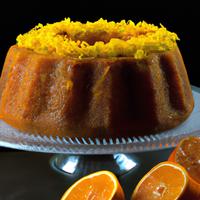
1 serving (100 grams) contains 250 calories, 4.0 grams of protein, 10.0 grams of fat, and 35.0 grams of carbohydrates.

Log this food in SnapCalorie

Nutrition Information
Calories |
595.2 | ||
|---|---|---|---|
% Daily Value* |
|||
| Total Fat | 23.8 g | 30% | |
| Saturated Fat | 7.1 g | 35% | |
| Polyunsaturated Fat | 0 g | ||
| Cholesterol | 71.4 mg | 23% | |
| Sodium | 357.1 mg | 15% | |
| Total Carbohydrates | 83.3 g | 30% | |
| Dietary Fiber | 2.4 g | 8% | |
| Sugars | 47.6 g | ||
| protein | 9.5 g | 19% | |
| Vitamin D | 0 mcg | 0% | |
| Calcium | 71.4 mg | 5% | |
| Iron | 2.4 mg | 13% | |
| Potassium | 238.1 mg | 5% | |
* Percent Daily Values are based on a 2,000 calorie diet. Your daily values may be higher or lower depending on your calorie needs.
Food Attributes
Source of Calories
About Bolo de laranja
Bolo de Laranja, or orange cake, is a popular dessert in Brazilian cuisine known for its moist texture and vibrant citrus flavor. The cake typically combines ingredients like orange juice and zest, flour, sugar, eggs, oil or butter, and baking powder, creating a simple yet refreshing treat. Often it’s topped with a light orange glaze, further enhancing its zesty profile. While it contains vitamin C from the oranges, Bolo de Laranja is primarily a sweet indulgence. Its sugar and fat content can make it high in calories, meaning moderation is key for those monitoring their dietary intake. This cake is ideal for celebrations or as a bright addition to afternoon tea, showcasing Brazil's love for incorporating fresh, tropical flavors into their desserts.



